How to Choose Climbing Shoes: The Definitive Guide (2023)

No piece of gear will have as much impact on your climbing performance as your climbing shoes. Shoes are the only piece of equipment that directly correlates to on-wall performance in all climbing disciplines, from bouldering to trad climbing. The rest comes down to fitness and skill.
So choosing the right shoes is one of the most significant decisions you’ll make as a climber.
You can always buy new shoes, but climbing shoes aren’t cheap. So it pays to make sure you’re happy with your shoes before you pull the trigger on a new (or your first) pair.
In this article, we’ll go through the whole process, from an overview of the modern climbing shoe to our method for “How to Choose Climbing Shoes” to some thoughts on fitting rock climbing shoes (which is very, very important).
What’s a Climbing Shoe?
A climbing shoe is a close-fitting piece of footwear designed exclusively for rock climbing. Unlike approach shoes or hiking boots, climbing shoes are designed to be worn only on technical rock (5th class and above). They feature minimal (if any) cushion and a sticky, durable rubber sole for grip. Climbing shoes commonly incorporate a downturn or “camber,” heel tension, and centralized pressure over the big toe for power on small edges.
History
Like the sport of rock climbing as a whole, early climbing shoes descended from mountaineering gear. Until the early 20th century, climbers made do with cumbersome, thick-soled hobnailed boots whenever an ascent required tackling pitches of rock.
By the late 1930s, however, various rock-specific models had advanced. These included a series of rubber-lugged boots, developed in late 1930s Italy by Vitale Bramani (Vibram’s founder). Similarly, British climbers like Joe Brown began experimenting on rock with rubber-soled sneakers following the Second World War.
The first true “climbing shoe” was developed by Frenchman Pierre Allain, who released the “PA” line of boots with hard composite rubber soles in 1947. Another French climber, Edmond Bourdonneau, bought Allain’s company shortly after the PA’s release, upgrading their design with his own model, the “EB.”
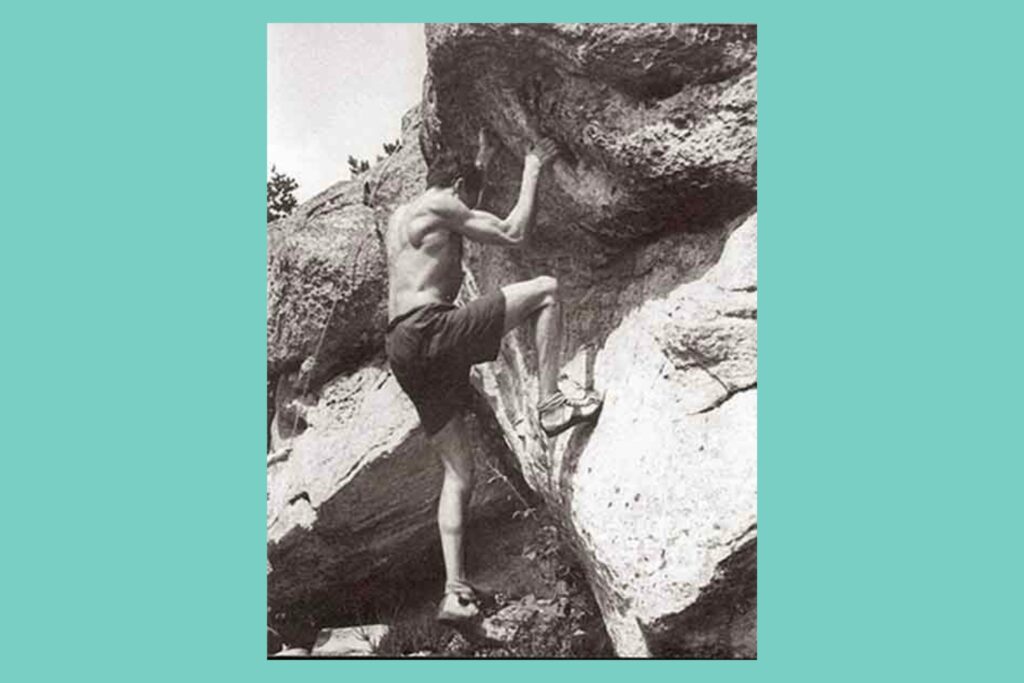
EBs, which debuted in 1950, featured softer, stickier soles than PAs, offering more sensitivity and better grip. By the end of the decade, they were the “default” European climbing shoe, and by the 1960s and 1970s, they’d spread around the world and were also the shoe most commonly used by Yosemite pioneers in America.
The final major milestone in shoe development was Spanish brand Boreal’s 1979 release of the “Fire.” This was the first climbing shoe to incorporate a custom climbing-specific rubber compound. Boreal’s release rendered EBs and other older models obsolete, catalyzing the birth of the modern climbing shoe evolution. Today there are hundreds of different models of climbing shoes.
Construction
The modern climbing shoe has four main components: the upper, footbed, midsole, and outsole. There are also a few auxiliary components. The most crucial of these are the rand, tongue, and closure. Let’s discuss all seven components of climbing shoe construction.
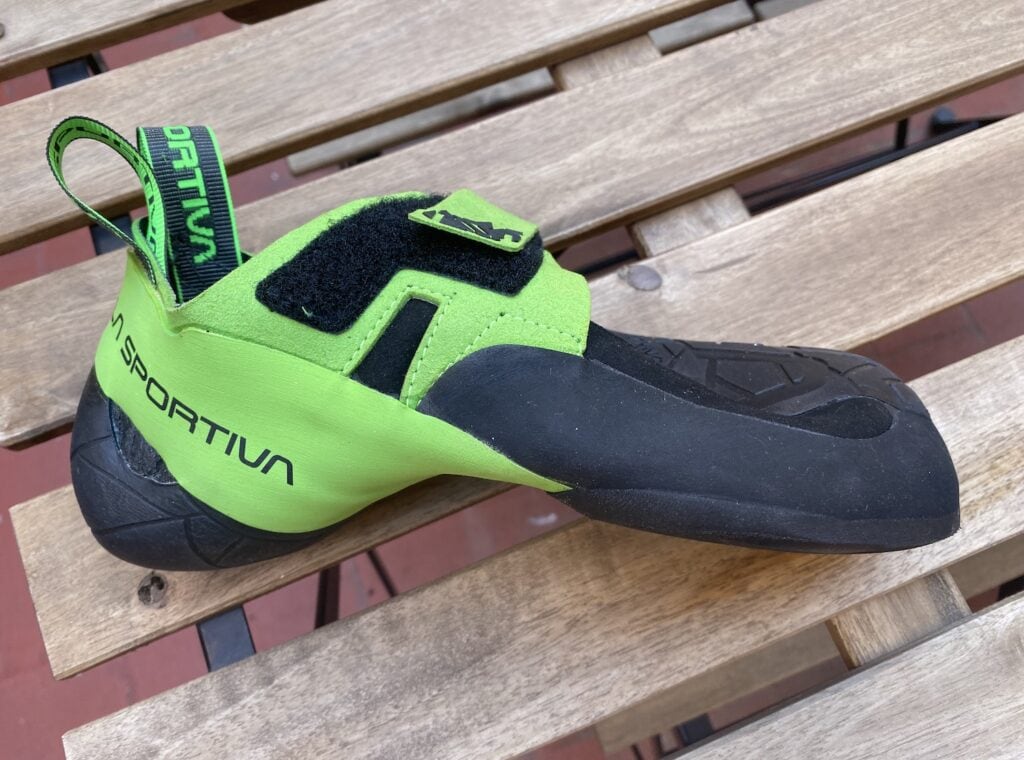
Upper
The upper of a climbing shoe is the top half of the shoe. Climbing shoe uppers are either leather, synthetic, or a hybrid of the two. Leather shoes are more breathable, durable, and odor-resistant than synthetic shoes, but leather does stretch slightly over time (sometimes up to a full size in unlined models). Synthetic shoes are often preferable for vegans or otherwise animal-conscious climbers, and also feature minimal stretch.
Footbed
Like any shoe, the footbed is the internal material your foot stands on. Rock climbing shoes’ footbeds are usually designed for comfort, interior grip, and odor control.
Midsole
The midsole rests below the footbed, between this and the outsole. Some shoes, like many aggressive bouldering models, don’t use a midsole, improving sensitivity and flexibility. Others, like most trad or big wall shoes, use rigid inserts (typically some sort of plastic) for added support.
Outsole
The outsole is the exterior lower half of the shoe. This is the main piece of grippy rubber that wraps around the bottom of the shoe. Different climbing shoes use different rubber compounds and different thicknesses. Most outsoles will be around 3mm to 5mm thick.

Rand
The rand is the added rubber piece wrapping around your shoe’s heel, sides, and forefoot. Rands are often used to foster tension in the shoe, powering your foot forward into the toebox and also protect various high-wear areas, like the heel and toe.
Tongue
The tongue of a climbing shoe is the loose flap secured by the closure. Tongues vary depending on shoe style and closure system. Like uppers, some are synthetic and some are leather. (The benefits of leather shoes and synthetic shoes are covered above.) Some tongues are also padded for extra comfort, and some feature a “split” tongue, improving breathability.
Closure
There are several closure systems used in modern climbing shoes: lace-up, velcro, and slipper. Each offers unique benefits and drawbacks, but ultimately it comes down to comfort and personal preference for many climbers. A closure style alone does not determine the value or performance of a shoe in a given scenario.
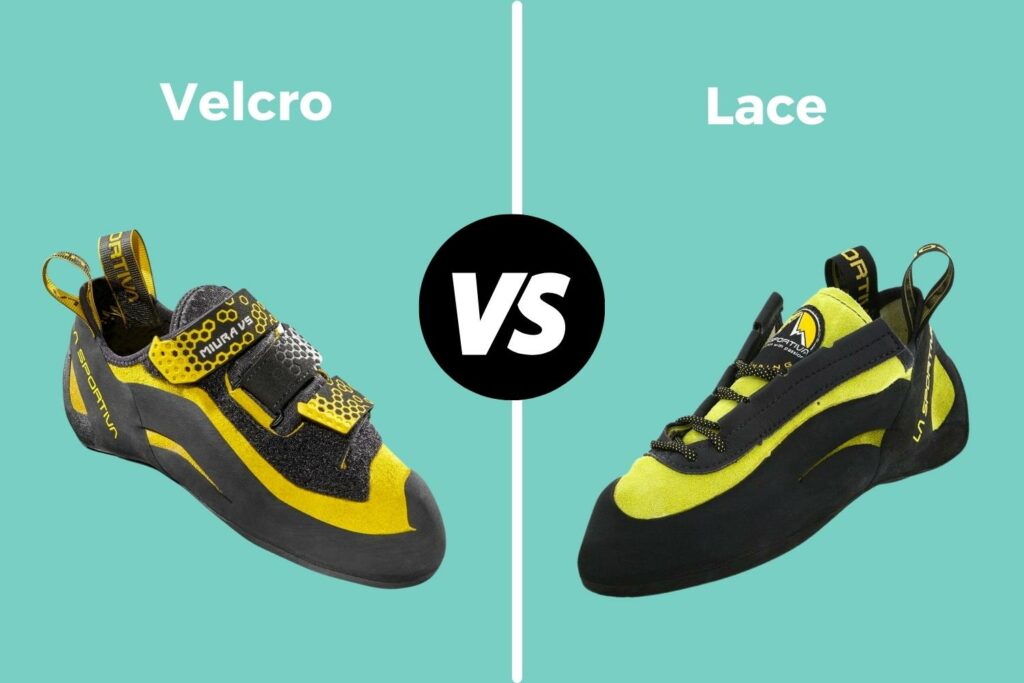
Lace-Up
Lace-up shoes are the oldest closure style of climbing shoes, but they’re still popular today, particularly with trad and multi-pitch climbers. Lace-ups take a bit longer to put on and take off than other models, but they allow for a more fine-tuned, nuanced fit. They’re much easier to loosen or tighten in small degrees during a long day, and are typically more secure thanVelcro shoes.
Velcro
Straps are the most popular closure system in modern climbing shoes. Velcro hook and loop closures are quick to slip in and out of, making them a top choice for gym climbing, sport climbing, and bouldering. They’re also the easiest style to aggressively tighten, jamming the foot forward for maximum toe box power.
For more information about the pros and cons of each closure type, read our article: Laces vs. Velcro Climbing Shoes: What’s Best?
Slipper
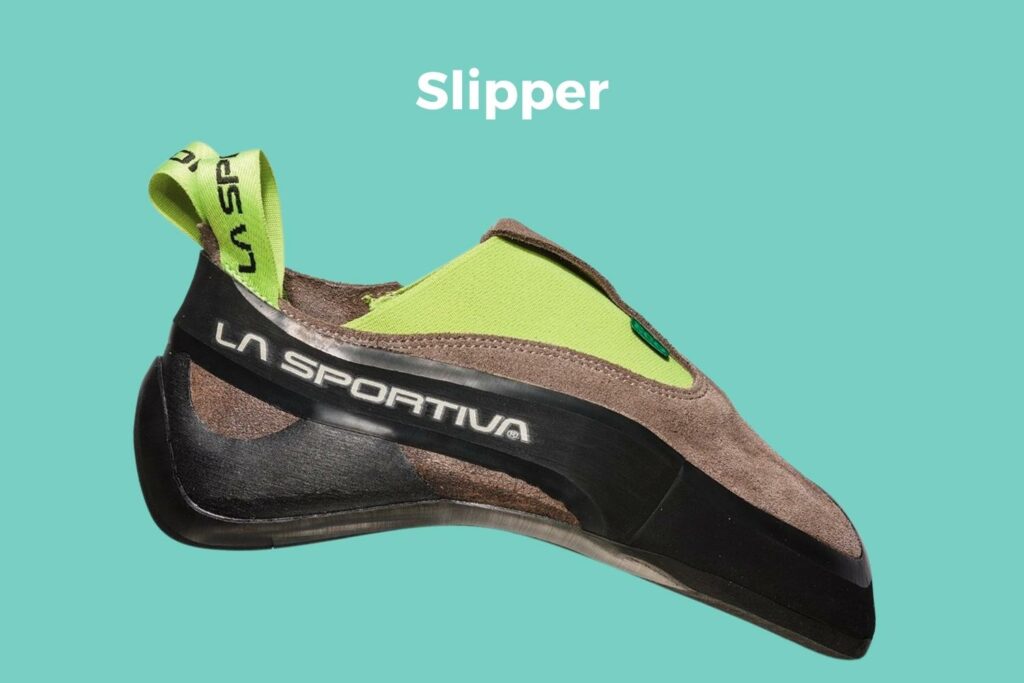
Slip-on shoes with elastic closures are the fastest to take on and off. Slippers offer the most sensitivity (and lowest profile) of any closure style and are commonly used indoors and on speed walls. Many crack climbers also opt for slippers to avoid bulky Velcro or lace closures. Slippers allow for more rubber coverage on the upper, improving durability in a jam-focused shoe.
Elastic closures tend to deform over time, so most climbers (if intending high-performance climbing) downsize more with slippers than other closure types.
The Different Types of Climbing Shoes
The biggest spectrum in climbing shoes lies between comfort and performance. The vast majority of the time, high-performance shoes aren’t comfortable, and comfortable shoes aren’t high-performing. There are exceptions, but you will generally have to sacrifice a bit of one to gain some of the other.
In addition to the tightness of the fit, three broad and interlinked categories contribute to a shoe’s position on the comfort vs. performance spectrum: downturn, asymmetry, and support.
Downturn
Climbing shoes can be broken into three categories: neutral, moderate, and aggressive, based on their natural downturn (or camber).
Flat or neutral
These shoes offer the most comfort for long days. Their last is flat like in normal street shoes. In general, neutral shoes’ main drawback is their performance, but for specific situations, like jamming in cracks and smearing on slabs, their flat profile is actually superior to moderate and aggressive shoes. Most beginner climbers start with a pair of neutral shoes.
Moderate shoes
These models are slightly downturned. They are built for “doing it all” on slab, vertical, and overhung faces. Moderately downturned shoes sit in the middle of the comfort and performance spectrum and are a great choice for your second pair of shoes.
Aggressive
Aggressive shoes are the least comfortable but most high-performing style of shoes, featuring a major camber that slots your toes and forefoot into a strong, powerful position for small footwork on overhanging terrain.

Asymmetry
When we say “symmetry,” we’re referring to the top-down view of the shoe, and a shoe’s symmetry typically runs hand in hand with its downturn. Neutral shoes are usually symmetrical (and thus more comfortable).
The more aggressively downturned a shoe is, the more asymmetrical it becomes, with a profile that curves towards the big toe. This leads to an aggressive shoe often becoming quite painful when worn for long periods but, as mentioned above, it increases power and precision for precise placements on small holds on overhanging rock.
Support
Rock climbing shoes offer varying levels of support. A shoe’s support typically runs counter to its sensitivity and flexibility. Neutral shoes have thick rubber soles and medium-to-stiff midsoles for extra support. This also means neutral shoes tend to last longer.
Moderate shoes have stickier rubber and thinner soles for better sensitivity and feel (without totally throwing support out the window). Aggressive shoes, meanwhile, have much thinner, more flexible builds and very little support, giving the climber maximum freedom of movement.
Stiff shoes with more support are ideal for beginner climbers. As a climber develops foot strength and technique, a shoe with less support and more sensitivity will facilitate higher performance.
Board vs. Slip-Lasted Shoes

The “last” of a shoe is the overall frame around which the shoe is constructed. Lasts determine a shoe’s heel and toe dimensions, width, instep height, and overall volume. Slip-lasted shoes are more sensitive and flexible, while board-lasted shoes are more rigid and supportive (and often more comfortable).
The former is usually chosen for short burn, high-performance efforts, like sport climbing, bouldering, and gym climbing, while the latter is usually used for do-it-all or all-day scenarios, such as trad and big wall climbing.
Board-lasted shoes are also helpful in crack climbing, adding structure to your foot when jamming. These stiff shoes are also the footwear of choice for most beginner climbers, offering extra support as your foot strength develops.
However, the reality is that board-lasted shoes are increasingly rare nowadays. Therefore, you’ll mainly have the choice between soft, balanced, and stiffer slip-lasted climbing shoes.
Our Method to Choose the Right Climbing Shoes
Now that we’ve seen the different types of climbing shoes available, we’ll help you match the right one with your profile depending on how long you have been climbing and the types of routes you climb.
1. Level of Experience
When thinking about how to choose climbing shoes, a few questions come to mind right off the bat. What makes great beginner shoes? When should you get downturned shoes? When do you know you’re moving into the moderate and advanced realm, and what should you start considering to send harder routes?
Foot Strength and Precision
As we discussed previously, the stronger and more experienced climbers are, the more aggressive shoes they’ll choose to wear. Wearing aggressive shoes isn’t a fast track to sending harder grades though. You need the strength and technique to use them properly, or you’ll actually be worse off than if you used a more neutral shoe.

That’s because aggressive shoes have minimal support and stability, thus relying almost entirely on a climber’s foot strength and technique to power over small holds. As you advance in skill and fitness as a climber, you’ll be able to wear more aggressive shoe models, but don’t jump the gun!
2. Climbing Length
Bouldering problems
Bouldering shoes are downsized more often than any other climbing shoes because you’ll only need to wear them for a few minutes. You can easily slip them off and on after hard attempts, so you can get away with wearing very asymmetrical and aggressive downturned shoes.
Single-pitch routes
Single-pitch routes are a toss-up. They’re short enough to get away with uncomfortable shoes, but if you want to send Advanced climbers will often wear aggressive or moderate pair of climbing shoes on difficult sport pitches, while beginner climbers should still stick to flat, neutral shoes. (Terrain also plays a role, however. Sometimes even the best climbers should wear flat shoes to maximize performance. See below.)

Multi-pitch climbs
Multi-pitch climbs take hours (even days), so you want to wear a comfortable, supportive shoe. Flat lasts and stiff midsoles will prevent foot pain during these long days on the wall. As the day goes on, your feet may swell, so lace-up shoes are also preferred, as they allow the most control over fit. The La Sportiva TC Pro is a perfect example of a classic multi-pitch shoe.
3. Terrain Steepness & Technique
Slab vs. vertical vs. overhanging
An aggressive shoe will perform better on overhanging terrain, propelling your power into the toe box. A flatter, more neutral and symmetrical shoe will perform better on lower-angle surfaces, like slabs, making it easier to get maximum friction contact when smearing. For vertical walls, a moderate shoe is often best. Again though, it ultimately comes down to personal preference and experience.

Crack climbing
Crack climbing involves jamming your feet into cracks in the wall to “create” a foothold through pressure on opposing sides of the crack. As a result, flatter shoes perform better in cracks. As we mentioned above, slip-on closures are also the closure system of choice for crack climbing, allowing for maximum rubber coverage (and an overall slim profile) on the shoe’s upper.
Hooking
Hooking is an advanced climbing foot movement performed with either the toes (toe hook) or the heel (heel hook). In either case, additional rubber needs to be in place to provide friction and protection. Shoes with a tighter heel cup promote more technical heel hooks, while rubber toe caps, with friction rubber stretching up across the top of the forefoot, help for toe hooking.
Gym vs. Outdoor
Most climbing shoes are suitable for climbing indoors on plastic or outside on rock. However, some shoes are designed especially for the gym. In that case, you should respect the manufacturer’s recommendations to ensure they last as long as possible.
4. Other Considerations
We have reviewed the main criteria specific to picking climbing shoes. However, like for any product, there are other important factors:
- Budget: aggressive shoes can fetch as high as $200, while you can find decent beginner shoes for $50. Don’t forget to resole before it’s too late to avoid buying another pair.
- Sustainability: climate change is dawning on us, and we are reaching the point of no return (1), making it more important than ever to buy responsibly from brands who truly care and act accordingly.
- Animal welfare: more than 1 billion animals are killed everywhere for leather (2). This doesn’t have to be: vegan climbing shoes are as good as leather ones. Just ask Alexander Megos.
How Many Pairs of Shoes Do You Need?
If you’re a beginner climber, you only need one pair of climbing shoes. Once you’re experienced enough to be dabbling and projecting in multiple disciplines and/or with different terrains and styles, then you can consider getting a second pair of shoes.
In general, your quiver should begin with a solid pair of comfortable, supportive, neutral shoes. Once you outgrow those you should expand into a two-shoe quiver, with one pair of neutral, comfortable shoes for training, trad, and multi-pitch climbs, and a pair of more sensitive moderate-to-aggressive shoes for projecting hard boulder problems or sport climbing.
Beyond this, the shoes you need will depend on your discipline, as we discussed above. How often do you climb indoors? How often do you embark on multi-pitch climbs? How often do you boulder? And so on.

Making a Shortlist
As a beginner climber, don’t stress too much about how to choose climbing shoes. Models like the Evolv Defy, La Sportiva Tarantulace, and Black Diamond Momentum are all great options for beginners’ shoes. So long as you find a shoe from a reputable brand that fits snugly and is comfortable, you’ll be doing just fine for your first pair of rock shoes.
But whether you’re a beginner, intermediate, or advanced climber, the process of making a shortlist is the same. Figure out what your goal is, and then choose a block of climbing shoes based on camber (neutral, moderate, aggressive).
Then explore that block, and choose three to four models to consider, paying particular attention to closure systems and material construction (leather vs. synthetic uppers, for example). Unless you already know specifically what you want (i.e. a flat slip-on for crack routes) your shortlist should probably include at least one shoe of each closure system.
You don’t have to stick entirely to your camber block. (For example, if you’re looking at neutral shoes, perhaps throw a moderate shoe as well.) But it’s helpful to figure out whether you’re looking for neutral, moderate, or aggressive climbing shoes before you start trying on models. Otherwise, it’s easy to get lost in all the options.
Now that you have a list, let’s find the best model based on fit.
How to Find the Right Fit
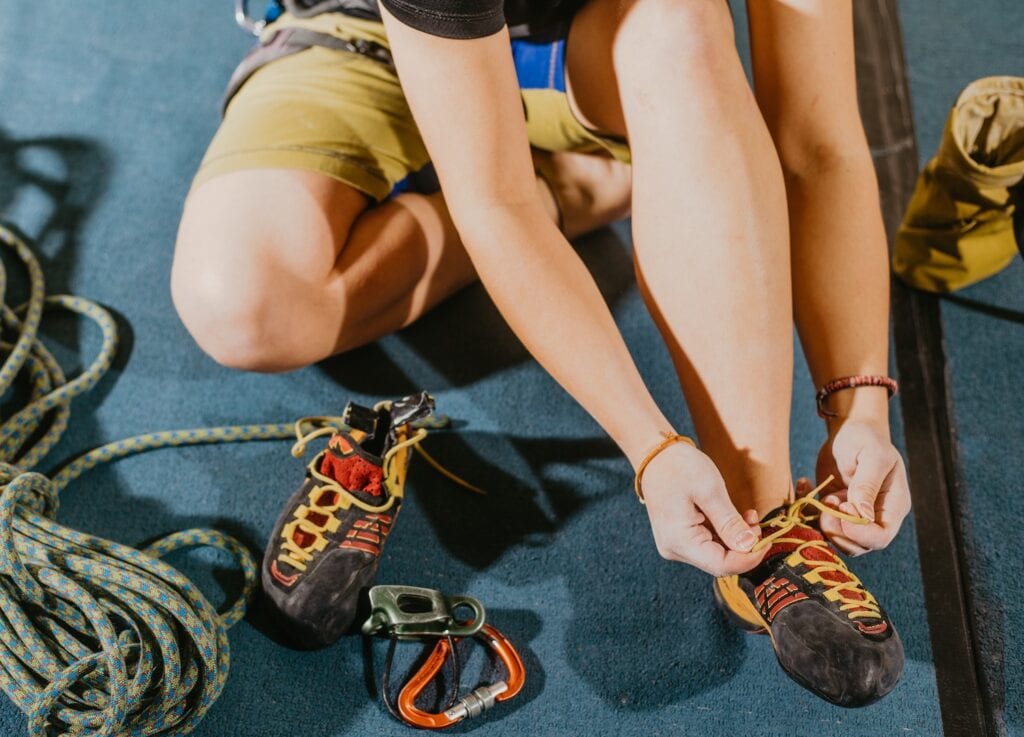
Foot Shape and Size
Some ancestry sites claim foot shapes determine genetic background, but there is no scientific evidence to support this, according to Healthline (3). The primary way feet are distinguished, medically, is by arch height. Humans either have low or flat (pes planus), medium, or high (pes cavus) arches. But there isn’t just one “arch” in your foot. There are three, running parallel to each other from heel to toe.
- The medial longitudinal arch runs from the end of your heel to the ball of your foot, right down the center of your foot.
- The lateral longitudinal arch runs along the outside edge of your foot.
- The anterior transverse arch runs from side to side, just behind the ball of your foot.
Arch height won’t play a huge role in climbing shoe fit, because climbing shoes are not designed to be worn on flat ground, but on vertical (or near vertical) walls. However, arch height can impact comfort, and you’ll need to test shoes on a case-by-case basis to figure out what fit works best for you.
Ancestral Foot Types

Those ancestral foot types mentioned above, though, can also play a role in fit. The three broad categories, according to PodExpert (4), are Egyptian, Roman, and Greek.
Egyptian feet (70% of all feet) are characterized by a gradual decrease in the length of the toes from the big toe down. Roman feet (25%) are characterized by three toes of the same length beginning with the big toe. Greek feet, the rarest (5%), are characterized by the second toe being the longest.
Don’t worry too much about selecting a shoe based on your toe length, but be aware that the comfort of your shoe’s toe box may change depending on your foot type. Most shoes (including climbing shoes) are designed with an Egyptian foot in mind, as this is overwhelmingly the most common foot type around the world.
Introduction to Climbing Shoe Sizes
Like all shoes, rock shoes are sized differently in the United States, United Kingdom, and Europe. American climbing brands will size more accurately in U.S. sizes, and the same is true of European brands. Some brands, like La Sportiva, are known for a particularly tight fit, while others, like Scarpa, are known to run a bit looser. Check out our extensive Shoe Size Database for more information.
Almost all climbers downsize a half size or more from street shoe size for optimal performance, but this is totally up to personal preference, shoe stretch (leather vs. synthetic), and your goals.
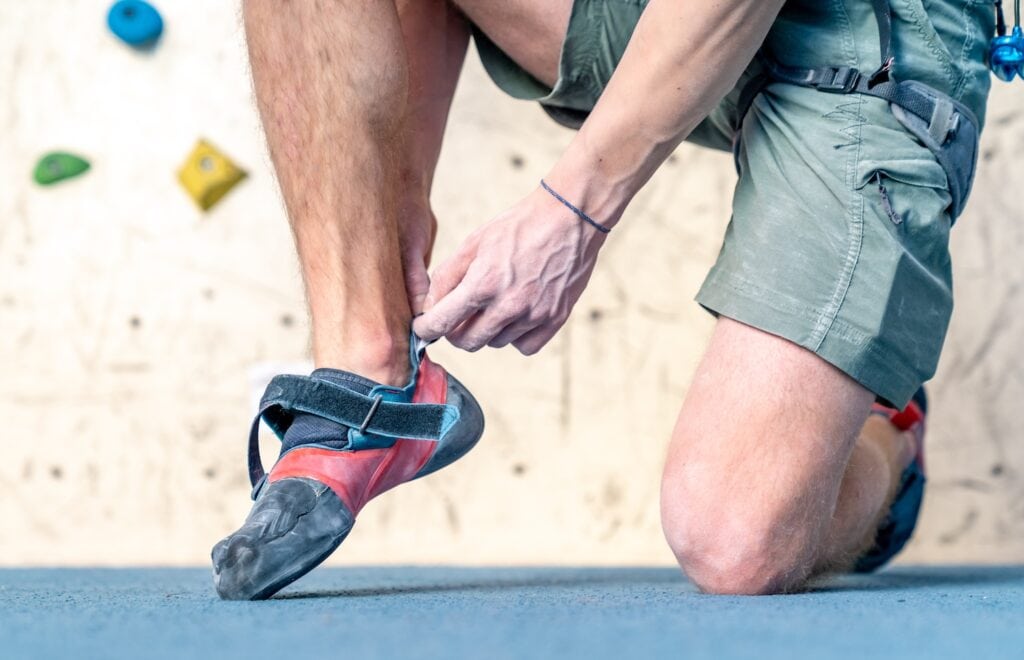
How Tight Should Climbing Shoes Fit?
In the rock shoe world, the most common question is how tight should climbing shoes fit? The answer varies. Every climber is going to accept a different level of tightness and discomfort. Boulderers and sport climbers often wear super-tight shoes because they can slip them off and on between short burns. Others, especially trad and multi-pitch enthusiasts, prefer shoes that can be worn for hours on end without discomfort.
In order to achieve maximum sensitivity A climbing shoe should be as tight as possible without causing pain. The best climbing shoe size is the one that you’re able to wear comfortably for the duration of your project (whether that’s a 15-foot boulder or a 1,500-foot big wall). If your shoe is hurting you while you’re on the wall, it’s no good.
For example, if your climbing shoe goes from “tight” to “painful” after fifteen minutes but you’re only using it for bouldering, that’s probably fine. For other disciplines, you’ll want a larger size.
Leather vs. Synthetic
As discussed above in our “Construction” section, leather and synthetic shoes offer pros and cons, one of those being the pliability of their fit. Synthetic materials maintain their size over time, stretching barely at all. They may soften up a bit (and can expand slightly if the upper is perforated) but in general, you shouldn’t expect a synthetic shoe to loosen.
Leather shoes, meanwhile, can stretch quite a bit with prolonged use. Sometimes leather shoes stretch up to a full size. This is especially true of unlined leather shoes. Check out our full-length guide for more on how to break in climbing shoes quickly and efficiently.
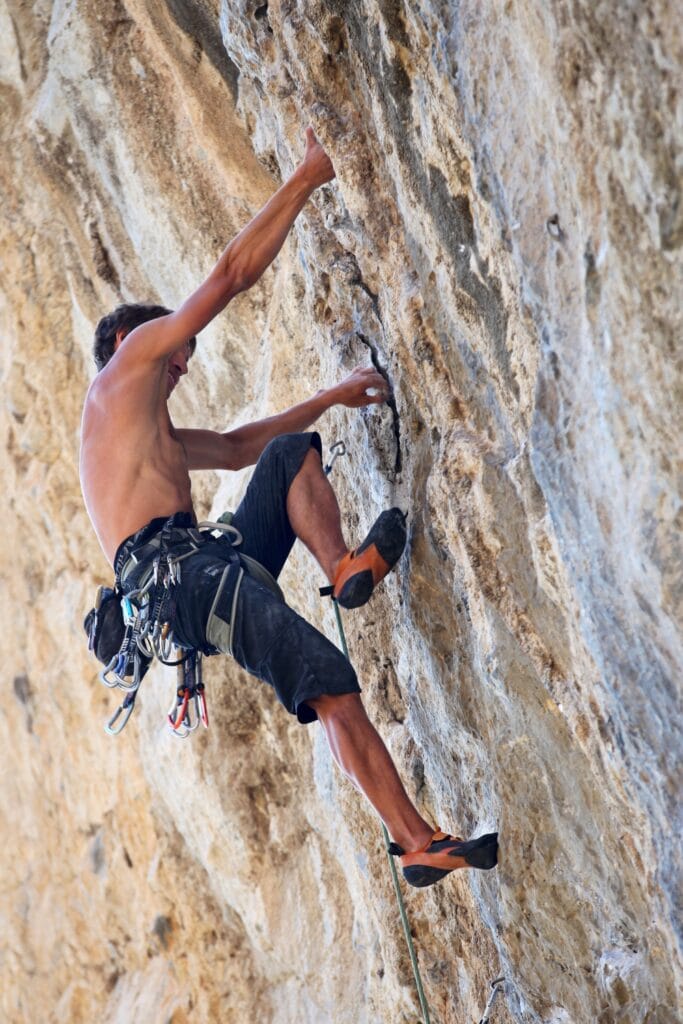
Final Thoughts: Go Easy!
In decades past, there were only a couple of options for climbing shoes. You didn’t have much choice. But today, rock shoes are as diverse and varied as the flora of a jungle. There are a slew of climbing shoe brands and dozens upon dozens of climbing shoe models to choose from.
But the most important thing with climbing shoes, in this author’s opinion, is to take it easy. The biggest mistake I see new climbers making is diving into a super aggressive model too early, just because they saw Ondra wearing it and they thought it would help them send harder. If you don’t have the strength to make use of that shoe, it’s actually probably going to decrease your performance.
So be conservative. Your climbing technique, foot and leg strength, and experience should improve ahead ofyour shoes, not the other way around.
As a new climber, focus on comfort first, and performance second. Choose climbing shoes that you can wear for long days on the wall, build your strength and skill, and then start thinking about more aggressive shoes. Climb on!
References
Climate Collapse Could Happen Fast
Lois Parshley (July 2023)
https://www.theatlantic.com/science/archive/2023/07/climate-change-tipping-points/674778/
Leather: Animals Abused And Killed for Their Skins
PETA
https://www.peta.org/issues/animals-used-for-clothing/animals-used-clothing-factsheets/leather-animals-abused-killed-skins/
Can Your Foot Shape Reveal Your Personality or Your Ancestry?
Rebecca Joy Stanborough (July 2019)
https://www.healthline.com/health/types-of-feet
The Different Foot Shapes and How to Fit Them
Philippe Vesin (March 2021)
https://www.podexpert.com/en/blog-pathology-type-feet-pxl-151_159.html
